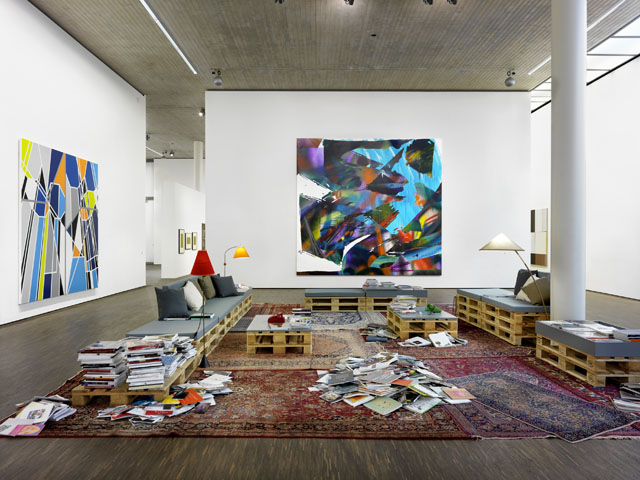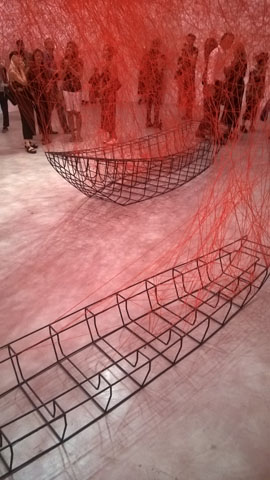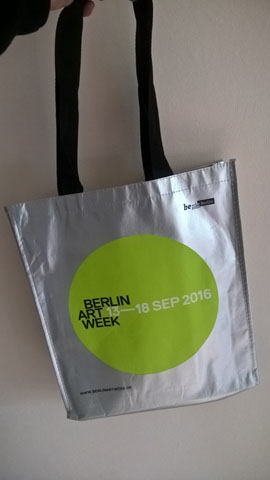Don't Dread the Bad End in a Bunker - Berlin Art Week, Part 2
- Christian Hain
- Sep 23, 2016
- 9 min read
Updated: Mar 25, 2020
(Berlin.) Art fairs are not the only thing happening during Berlin Art Week, there are gallery openings, conferences, institution openings, art-related parties, and did we mention the openings?
It seems fitting to commence part 2 of our Berlin Art Week special with an event called Angst 2 at Hamburger Bahnhof. Angst (i.e. “Fear”) is an “art opera in three acts” by Anne Imhof performed months apart in various European cities. Now, “Opera” is quite a misleading description: There is no obvious narrative, no orchestra or aria singing, and less of all an overweight lady to finish it – or so we presume, the third, and final, part has not been staged yet. This doesn't mean, Angst 2 would entirely forego eardrum shattering shrieks (soprano is the reason we cannot stand a classic opera, which, of course, is very ignorant of us). The museum’s main hall had been filled with fog – remember how we mentioned Ann Veronica Janssen lately? – and performers looking as bored as possible this side of a Beckett piece. From time to time they engaged in frightening actions or frightened reactions.
Angst 2 is a play of allusions, hints and motives that involve creepy sounds, a tightrope and people wet shaving each others arms and backs. As the piece progressed you observed more and more marks of reddened, though not cut, skin on all of them. Maybe it’s supposed to evoke flaying like Anish Kapoor’s take in the Marsyas myth did a couple of years ago? Some shaved themselves, and one crouched on the floor pressing his arm to the concrete to make “the veins stand out like highways all along [the] wrist”. They unfortunately forgot the armpits of one of the main performers that remained hairy, extraordinarily hairy. This person was exemplary for Imhof’s choice of androgynous performers, with long hair and a tight bandage wrapped around the bare chest; it was really hard to tell the sex, and the same goes for others among the cast – does this stand for another fear, of losing our identity in a uniform/homosexual ("monogender") society?
Angst 2 went from hairy to scary, the soundtrack changed to car engines (the event was sponsored by BMW, which might or might not have had anything to do with it), and Tino Sehgal-esque humming: “Hah Hah Hah - Oh Oh Oh Oh” (rep. ad nauseam). Performers were taking care of it personally. Freestanding spiral stairways led not to heaven, and punchbags were none, but of a less solid material. Performers even dared to smoke. And walk that tightrope with the help of a safety leash that kind of destroyed the effect (1960s performance artists would have spent the entire Art Week up there, without any safety measures; but that was before the world went mad with existence). Once, a person on top of a stairway held out a cigarette, and the acrobat refused to partake - to manifest a fear of refusal and failed communication? Drones (menacing politics) and pallets of Coke light cans (for the obese-o-phobes) also played a role. The drones latently threatened and occasionally assaulted performers and visitors, but did not carry bombs. The coke cans got emptied over heads and shoulders.
Angst 2 offered no new insights. Nor was it aesthetically pleasing. And yet we remained scotched for an hour and a half. We could not stop watching. So it’s like a car crash? No, and not a horror movie either. Maybe you could compare it to one of those teleshop commercials that you cannot make yourself stop watching, though you are perfectly aware nothing will happen; but that wouldn’t be nice. Do we regret the time we spent with Angst 2? No. Would we buy the soundtrack on Deutsche Grammophon? Hell no!
Some years ago, Tour de France was the pharmaceutical industry’s PR channel of choice, but then the do-goodies destroyed it all, and desperate PR managers were forced to find other ways to spend their budget. Art is one of those. Schering Foundation operates an exhibition space on Unter den Linden Avenue, close to Deutsche Bank Kunsthalle. Crammed in between skyscrapers, the cosy patio offers a cathedral-like feeling, and the opening supper consisted of wine and pretzels (-> Oktoberfest!), for free. Lucky visitors sat in a line, back to the wall, and scrutinized the less lucky standing around bar tables in the centre. Their only chance of escape was the show: Yvonne Roeb’s Im Überall - literally: “In the Everywhere”. It has bugs and bones, chimeraes, dream catchers, impaled rabbits and chained snakes, all drawn and sculpted, violent, or only natural, art presented in twilight with some recourse to wunderkammers (we’d love to see Roeb’s works at Musée de la chasse et la nature). Worth a visit!
From the bus home we discovered another space for art and drugs that we’d never heard of: Sanofi-Aventis hosts one show per year in their offices on Potsdamer Platz, currently it’s German painter Christian Awe. Very colourful. So colourful indeed, you’d love to ask them what combination of pills would make the effects last.
Not only great shows happen in Berlin Art Week, but also those you regret visiting immediately - attacking colleagues is a no-no, but, dear Spike Art Quarterly, there is a reason why you seldom welcome more than a handful of visitors in your attempts at curating.
The guys from The Dark Rooms had a one day show in a bar, and even in daylight, some of it is impressive. There are also lots of fresh gallery shows, only to mention a few: The last time we reported for duty with Captain Petzel, we did not particularly like it, "arr". This time it’s better. Despite Sean Landers being a painter, a figurative one. Landers does soft surrealism, and one collector will outsmart all others by buying the diptych of a forest with interpretation keys to the rest of the show written on the tree trunks.
Wentrup Gallery rented a second space, and agreed to pay for it in vowels. WRNTP,... no: WTPRN,... no: WNTRP – don’t ask us how to pronounce that! – opened with videos of Hicham Berrida, Jean de Loisy’s personal protégé. If you’ve been to Palais de Tokyo anytime in the past three years, you had zero chance to escape seeing some work of his. And he’s good. At WNTRP, Berrida shows three videos of chemical reactions that in reality take no more than the fraction of a millisecond.
We’ve been to Blain Southern again. And got caught in an installation of Chiharu Shiota, the ultimate selfie art, perfect for an event like Berlin Art Week. Between spiders weaving a blood-red web, the veins of the space, and burning barques, the Japanese artist creates a woven labyrinth. All yarns have been attached with standard staples, we challenge you to count them. The gallery assistant refused to name a price for this huge installation, the smaller works on the first floor go for five figure sums. A must see. And BS had much better craft beer on offer than Koenig.
Judin Gallery next door shows Dieter Meier of Yello fame (yes, we know, he’s always been a “true” artist, but still) who spent the night sitting at a table and dedicating posters; he did not chat with us as he did with others. We already had a business card at hand, maybe he smelt that; he gave us no chance to hand it over. It is a special situation to find yourself this close with position 275 of the Swiss Rich list, an artist slash investor with an estimated net worth of CHF 200 million (that must be trillions in purchasing power anywhere outside Switzerland). We’d almost begged him for a watch, but he sold his stake in Ulysse Nadin three years ago for an easy 90 million; he could still have served us homebred beefsteak and pampa wine (that’s all peanuts compared to other projects of the art world’s answer to Warren Buffet). But at his compatriote and former Cinema operator Jürg Judin's gallery he appeared in his artist personality. Meier shows photo portraits with a story, possible biographies, a project he’s started forty years ago, and like his own multiple personalities, he cannot let them go. Cindy Sherman inspired broken dreams, success stories and infinite possibilities, art about time going by and what could have been and what could be. Dieter Meier is a skilled actor, maybe that has been the key to his success all the time.
Opposite, our friends from Jiri Svestka once again host a show worth visiting with early works of Georg Ettel. Instead of visiting Ugo Rondinone at Esther Schipper/Johnen Gallery (the merger created a buzz in Berlin lately) on the opening night, we had to bring our precious Meier poster home, then went for Struction and A Bad End Story. Struction impressed with a ridiculous long artist list, and surprised with the question where all those works were hidden. There was art on two levels of yet another abandoned industrial site next to abc fairground, it also hosted Berlin Biennale’s closing party on Saturday. Struction somehow centred around raising and falling pieces of architecture, on de- and con-, and decon- and in- and recon-struction. Art professor and part time pub owner Karsten Konrad built a canoe bigger than Shiota’s at BS (both might actually be a nod to Peter Doig’s “hobos in canoes” series and the erstwhile most expensive contemporary painting White Canoe???). The show was quite void of visitors, and much of it looked like done by the Pedro Cabrita Reiss appreciation club. We liked some coloured x-hedrons by Tanja Rochelmeyer, and witnessed a concert for corrugated iron and coat hanger with a musician who could have been Dieter Meier’s granddad. This was the legendary Bob Rutan, and it’s a pity the number of listeners did not even equal half the number of his years.
Later that night, A Bad End Story, a Jägermeister PR event disguised as an arts and music show. The free Jäger was limited to two shots or one long drink each, and it was not for free but the cheap payment for visitors’ image rights: A paper sign at the entrance advised on a promotional video being shot. We get tired of writing about horror movie set industrial site venues, suffice to day this was another. Security took care of people talking too loud outside, for the neighbours’ sake. As always with Jäger and other sugary liqueurs, the bad end was the morning after.
Berlin Art Week had started with me. Or ME, we told about them earlier. My Abstract World (why not "The Abstract Side of Me", or "Me and my Abstraction", or ...?) features abstract paintings from Mr. Olbricht’s collection, and a musicologist has selected music to accompany them. Not a song from the same era for each work, but synesthesian interpretations to add to the experience. One figurative work by David Nicholson (a female act) sneaked in between all the Frizes, Armleders, Longos, Grosses and Knoebels. Each of the three rooms has a coffee table and a chaos of catalogues (auction and art), books and magazines in the centre; possibly to prove the futility of interpreting abstraction. And figurative is mere lines on a canvas, that’s why Nicholson’s nipples, right?
And in the end, on Berlin Art Week’s closing day, we decided to give Mr Boros a try. Christian (Krystian) Boros is an art collecting advertisement mogul who lives in a bunker in Berlin-Mitte; he's one of Berlin’s major players with all the means to “make” an artist. Boros’ bunker is a special type of bunker, not your regular under the earth thing, but a concrete block six storeys high which is really considerate for attacking airplanes. The nazis built it, the communists used it, and later it was a swinger club with music before being invaded by art. Boros only uses the duplex penthouse for himself and his family and shows his art collection below. The boulder in front of the building is an artwork, the bullet holes are not. Most people queuing believed the visit would be for free during art week, but alas, that was not the case.
One of the artists in Boros’ stable is Alicja Kwade. She has quite a few works in the show, not all of them on the same level. What looks like a Carl Andre plate mishandled by art handlers who ran away when it shattered on the floor, is hers. What looks like a Penone – or maybe it’s just us who think “Penone” every time we see wood in an exhibition – is hers too. The neon lights that double as heaters are not Dan Flavins but somebody else's. And there’s popcorn for all, gratuitously dispersed on the floor by a forsaken popcorn stand, a church bell to ring, and a synthesizer to play on. Occasionally you admire not art but architecture, a bunker phone or military grade torches in the staircase (you can switch them on to annoy the guards!). There’s Ruff and Tillmans, and many more, thing is you never know who’s who. Out of Art Week, the bunker only opens for guided groups; there are no labels, and not even a leaflet. We were tempted to steal a catalogue from the heap down a stairs. To see art without guidance is indeed an issue when confronted with these rather abstract works. You’re so much used to explanation and guidance, you miss it. You need a name, a label, a brand, you need product information – got it? You need corporate communication, you need: advertizing.
A hole in the wall offered a glimpse into the roof garden, the sun was shining, but we did not see Mr Boros in tiger tangas sipping beer on an easy Sunday morning.
Oh yes, Ugo Rondinone: we went on another day when the world outside looked as grey as his window sculptures. U go there, if you don’t know him, otherwise you don’t have to. And that’s all about this year’s Berlin Art Week.
Berlin Art Week 2016, Berlin
World of Arts Magazine - Contemporary Art Criticism
















Comments